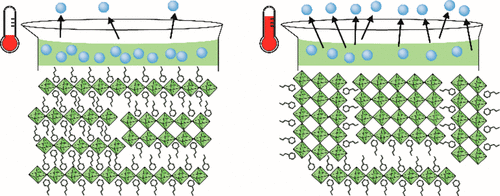当前位置:
X-MOL 学术
›
ACS Photonics
›
论文详情
Our official English website, www.x-mol.net, welcomes your feedback! (Note: you will need to create a separate account there.)
Significance of Ambient Temperature Control for Highly Reproducible Layered Perovskite Light-Emitting Diodes
ACS Photonics ( IF 7 ) Pub Date : 2020-07-08 , DOI: 10.1021/acsphotonics.0c00779 Yaeeun Han 1 , Jian Wang 2 , Connor G. Bischak 2 , Sohyeon Kim 1 , Kangmin Lee 3 , Dongjae Shin 1 , Mi Jung Lee 3 , David S. Ginger 2 , Inchan Hwang 1
ACS Photonics ( IF 7 ) Pub Date : 2020-07-08 , DOI: 10.1021/acsphotonics.0c00779 Yaeeun Han 1 , Jian Wang 2 , Connor G. Bischak 2 , Sohyeon Kim 1 , Kangmin Lee 3 , Dongjae Shin 1 , Mi Jung Lee 3 , David S. Ginger 2 , Inchan Hwang 1
Affiliation

|
Achieving high reproducibility in materials properties of perovskites is critical to the reliable development of optoelectronic device applications such as photovoltaics and light-emitting diodes. However, it can be difficult to obtain reproducible and optimized performance from these materials, particularly for reduced-dimensional perovskites, because different 2D/quasi-2D perovskite layer numbers have similar formation energies. Here, we report that variations in the exact ambient temperature during solution processing, even in the small range of 21–31 °C, as may occur during the day or across seasons, influence the formation and crystallographic orientation of Ruddlesden–Popper phase perovskites with a formula of PEA2MAn–1PbnBr3n+1. We find that growth at a lower ambient temperature (∼21 °C) predominantly favors low-n phases of the perovskite, especially n = 1 with an orientation parallel to the substrate. Conversely, higher ambient temperatures (∼26 and 31 °C) yield a larger fraction of high-n phases with a vertical orientation and suppressed the formation of the low-n phases. We show that the coexistence of parallel and perpendicular orientations leads to improvements in the electrical and photophysical properties, and consequently improved light-emitting device performance. Furthermore, higher ambient temperatures affect the surface morphology through the formation of cubic grains. Consequently, the precise ambient temperature yields a relative standard deviation of 9.9% for maximum luminance, while uncontrolled temperature causes a high relative standard deviation of 71.4%. These findings highlight the importance of ambient temperature control during processing of layered perovskites. We anticipate that this study should help the field of optoelectronic device research improve the reproducibility in the fabrication of low-dimensional perovskite-based devices.
中文翻译:

高度可复制的层状钙钛矿发光二极管环境温度控制的意义
钙钛矿材料性能的高再现性对于光电器件应用(如光伏器件和发光二极管)的可靠开发至关重要。但是,由于不同的2D /准2D钙钛矿层数具有相似的形成能,可能难以从这些材料中获得可重现和优化的性能,尤其是对于尺寸减小的钙钛矿而言。在这里,我们报告说,即使在白天或整个季节可能发生的溶液加工过程中,即使在21-31°C的小范围内,精确的环境温度变化也会影响Ruddlesden-Popper相钙钛矿的形成和晶体学取向。 PEA 2 MA n –1 Pb n Br 3的公式n +1。我们发现,在较低的环境温度(约21°C)下生长主要有利于钙钛矿的低n相,尤其是n = 1且平行于底物的取向。相反,较高的环境温度(约26和31°C)会产生较大一部分具有垂直方向的高n相,并抑制了低n相的形成。阶段。我们表明,平行和垂直方向的共存导致电和光物理性质的改善,并因此改善了发光器件的性能。此外,较高的环境温度通过立方晶粒的形成影响表面形态。因此,精确的环境温度可为最大亮度提供9.9%的相对标准偏差,而不受控制的温度会导致71.4%的高相对标准偏差。这些发现突出了层状钙钛矿加工过程中控制环境温度的重要性。我们预计,这项研究应有助于光电器件研究领域,提高低维钙钛矿基器件制造的可重复性。
更新日期:2020-09-16
中文翻译:

高度可复制的层状钙钛矿发光二极管环境温度控制的意义
钙钛矿材料性能的高再现性对于光电器件应用(如光伏器件和发光二极管)的可靠开发至关重要。但是,由于不同的2D /准2D钙钛矿层数具有相似的形成能,可能难以从这些材料中获得可重现和优化的性能,尤其是对于尺寸减小的钙钛矿而言。在这里,我们报告说,即使在白天或整个季节可能发生的溶液加工过程中,即使在21-31°C的小范围内,精确的环境温度变化也会影响Ruddlesden-Popper相钙钛矿的形成和晶体学取向。 PEA 2 MA n –1 Pb n Br 3的公式n +1。我们发现,在较低的环境温度(约21°C)下生长主要有利于钙钛矿的低n相,尤其是n = 1且平行于底物的取向。相反,较高的环境温度(约26和31°C)会产生较大一部分具有垂直方向的高n相,并抑制了低n相的形成。阶段。我们表明,平行和垂直方向的共存导致电和光物理性质的改善,并因此改善了发光器件的性能。此外,较高的环境温度通过立方晶粒的形成影响表面形态。因此,精确的环境温度可为最大亮度提供9.9%的相对标准偏差,而不受控制的温度会导致71.4%的高相对标准偏差。这些发现突出了层状钙钛矿加工过程中控制环境温度的重要性。我们预计,这项研究应有助于光电器件研究领域,提高低维钙钛矿基器件制造的可重复性。


























 京公网安备 11010802027423号
京公网安备 11010802027423号